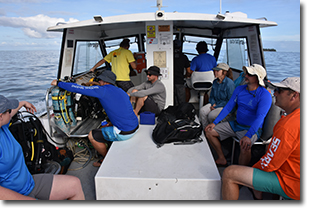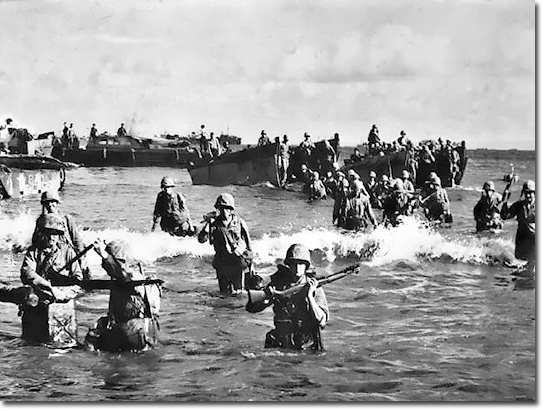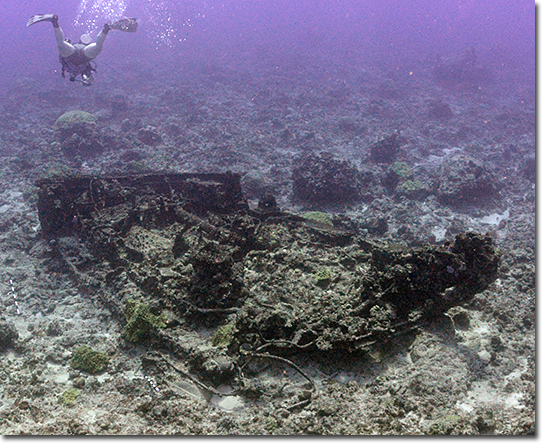Operation TATTERSALLS - Part 1: The History
By Dr. Jennifer McKinnon
Headed to Tinian (Photo by J. Carpenter).
Thus far, we've worked only in Saipan and so we have been eager to expand to the island of Tinian, to the south, and see what is left of the underwater maritime heritage from WWII.
The US's plan to take control of the Marianas from Japanese forces was code-named FORAGER. Saipan, home of the administrative center of the Japanese Marianas, was chosen as the first target with Tinian and Guam as secondary. The plan to invade and take control of Saipan was called Operation TEARAWAY, while the battle for Tinian was called Operation TATTERSALLS.

Battle for Tinian by James Hunter.
United States planning and preparations for the assault on Tinian began as the battles for Saipan and Guam continued. Tinian, like Saipan and Guam, was needed for airbases and troop staging areas, however the 9,000-man Japanese garrison on Tinian had to first be eliminated in order to prevent raids and artillery attacks on nearby Saipan.

Marines wading ashore on Tinian (Photo courtesty of The National Archives).
In early June 1944, it was decided that intensive terrestrial, naval, and air bombardments should be launched to prepare for the US invasion of Tinian on J-Day (24 July). Using the 155mm Long Tom and Howitzer guns on Saipan's southern shore in conjunction with naval artillery and bombers, US forces were successful in maintaining an offensive position while invasion preparations were made. The air strikes of Tinian by P-47 aircraft also brought a new technology to war in the Pacific: the napalm bomb, an effective means of removing ground cover and revealing Japanese fortifications.
Despite their narrow widths, White Beach 1 (65 yards) (locally called Unai Babui) and White Beach 2 (130 yards) (called Unai Chulu) were chosen for the marine landing. Fortunately for the US, Japanese confidence that the beaches could not be used by US troops because they were so narrow led to little fortification of the beaches; several boat mines on White 2 were the only obstacles encountered.
US forces left Tanapag Harbor (Saipan) on the evening of 23 July. Members of the 4th Marine Division were loaded onto amphibious tank landing ships (LSTs) while the 2nd Marine Division led a feint against the Japanese stationed at Tinian Town to draw the Japanese out. Upon return to the transports, members of the 2nd Marine Division were re-embarked to the White Beaches. Meanwhile, the 4th Division was successfully landed on White 1, meeting little opposition from Japanese troops. Marines on White 2 faced greater challenge; heavy rain delayed UDT removal of several coral boulders and anti-boat mines. Several of the offshore cruisers, gunboats, and destroyers fired on the beach in hopes of deploying the mines. Marines were eventually able to land on White 2, and by 1337 hours, engineers had cleared the beach of mines.
Over the course of nine hours, a front running 4,000 yards long and 2,000 yards deep was established on White Beach 1. Crevasses and caves in the vicinity consistently harassed the Marine battalions as they came ashore, however pontoon ramps for LVTs constructed by the Seabees at White 1 aided in quickening the movement of equipment over the low beach cliffs. While one of the ramps overturned (as well as an LVT), the other ramp remained intact despite rising sea swells. By 1600, the Marines had won control of the beachfront, allowing flame tanks to land. These tanks in turn provided much needed support for the Marines on White 2, who had encountered booby traps, mines, Japanese mortars, and artillery fire further inland. By the end of the day, communication was established between the two beaches. 'Jig-Day' closed with 15 Marines killed in action and 225 wounded and over 400 Japanese were counted as dead.
Operation TATTERSALLS - Part 2: The Archaeology
With a list of vehicles used in the invasion of Tinian and historical accounts outlining the event, we headed across the
channel which is about a 1.5 hour boat ride to investigate the invasion beaches.
| Type | Number |
|---|---|
| Landing ship, dock (LSD) | 2 |
| Landing ship, tank (LST) | 37 |
| Landing craft, infantry (LCI) | 31 |
| Landing craft, tank (LCT) | 20 |
| Landing craft, mechanized (LCM) | 92 |
| Landing craft, personnel (LCVP) | 100 |
| Pontoon barges | 14 |
| Troop transports | 10 |
A portion of the project was devoted to examining Tinian's WWII invasion beaches Unai Babui (White Beach) and Unai Chulu (White Beach 2). Because only one remote sensing survey had been previously conducted by SEARCH, Inc. of Unai Chulu, we wanted to follow up on that survey and jump the potential anomalies, but also conduct swim line searches of Unai Babui. As such, we utilized the SEARCH survey to identify significant anomalies and dive on the targets at Unai Chulu. All of the anomalies were dived on and resulted in the crew finding an enormous WWII Danforth anchor and a previously unknown, fairly intact LVT in approximately 45 ft of water. This LVT may be one of the LVTs that swamped according to Navy records. Luckily we had an LVT expert with us, Navy Archaeologist Shawn Arnold (who wrote his master's thesis on LVTs), and was able to identify it as an LVT-2. Photographs were taken of the site and GPS locations were recorded. This information will go into a database of known sites and also will help us to write the military terrain analysis for the battle.

LVT2 at Tinian (Photo by W. Hoffman).
Swim line searches were conducted at Unai Babui and portions of a second LVT were located in approximately 20 ft of water. This LVT must have been subjected to a catastrophic event because it is in parts and scattered over about a 50 meter area. Another large stockless US Navy anchor was found in 20ft of water and a tire which might belong to a DUCKW, a six-wheel-drive amphibious modification of the 2 and one half ton CCKW trucks used during WWII. The DUCKW was used for transporting troops and equipment on land and on water. Further research on these sites may reveal the specific vehicles because so few were lost and the details of their losses are known through documentation.
Previous Next

